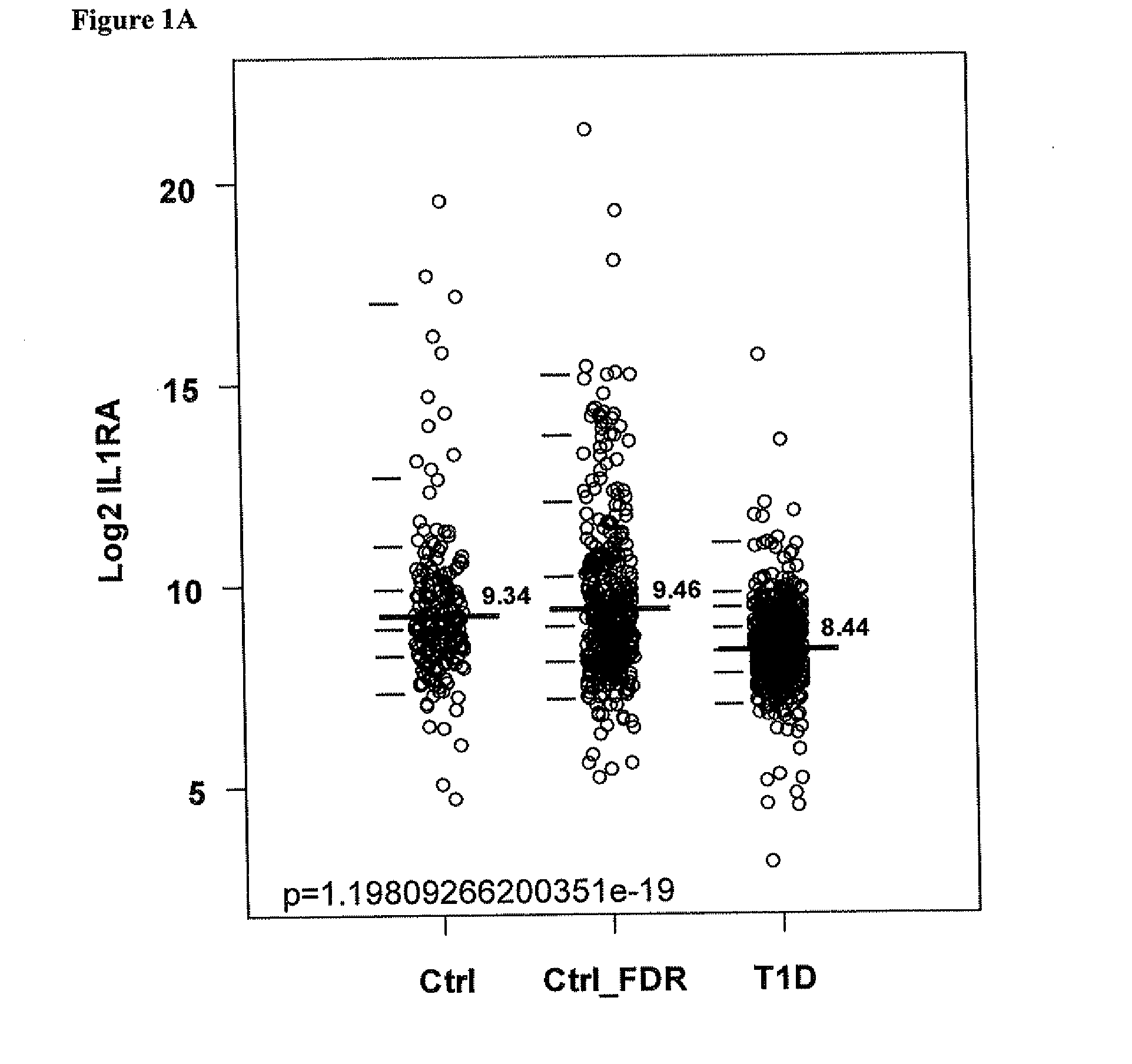Biomarkers and therapeutic targets for type 1 diabetes
a type 1 diabetes and biomarker technology, applied in the field of biomarkers and therapeutic targets for type 1 diabetes, can solve the problems of poor specificity and sensitivity of susceptibility genes for disease prediction, subset of autoantibody-positive (abp) subjects never progress to clinical disease, and achieve the effect of decreasing il-1ra levels
- Summary
- Abstract
- Description
- Claims
- Application Information
AI Technical Summary
Benefits of technology
Problems solved by technology
Method used
Image
Examples
example 1
Reduced IL-1Ra in T1D Patients
[0178]Methods
[0179]Patients and Samples
[0180]The first dataset (DISCOVER) consisted of 682 autoantibody-negative (AbN) controls and 697 T1D patients, while the second dataset (CONFIRM) included 1696 AbN controls and 1586 T1D patients. The subjects in these two datasets were participants in the prospective assessment in newborns of diabetes autoimmunity (PANDA) study. All subjects were Caucasians living in the State of Georgia and randomly selected from the PANDA cohort. The characteristics for the subjects are summarized in Table 1.
TABLE 1Demographic and laboratory information on the cross-sectionaldatasets.AbNT1DP-valueDISCOVER datasetSexFemale3633700.99Male319327HLA Genotype0201 / 020155605.5 × 10−220302 / 030240520201 / 0302922130201 / x137790302 / x153149x / x15254Age (years)22.9 ± 18.329.1 ± 18.98.1 × 10−10Duration of T1D13.0 ± 14.1(yrs)CONFIRM datasetSexFemale9328000.01Male764786HLA Genotype0201 / 02011261401.1 × 10−470302 / 0302981140201 / 03022134430201 / x37032303...
example 2
Serum Protein Changes in T1D Patients are Associated with Increased Risk of T1D
[0190]Results
[0191]To evaluate the risk of T1D logistic regression was used to analyze the serum concentration of proteins as a linear variable. The analysis suggested that lower serum levels of IL-1Ra, MIP1b, IL8, MCP-1 and MPO has an very high odds of having T1D (Table 2). similarly increase serum levels of SAA, IGFBP2 and ADIPOQ has an increased risk of having T1D (Table 2),
TABLE 2Odds ratio of having T1D, using serum proteins as linear variableProteinORp-valIL1Ra0.58 (0.5-0.68)1.00E−12MIP1B0.74 (0.66-0.83)4.70E−07IL80.65 (0.58-0.73)8.30E−13MCP10.63 (0.54-0.72)5.60E−11SAA1.15 (1.02-1.29)0.018IGFBP2 2.1 (1.82-2.42)8.20E−25ADIPOQ1.95 (1.73-2.19)1.00E−27MPO0.51 (0.46-0.56)4.00E−42
[0192]Next the serum samples were analyzed by converting the serum concentration of IL-1ra, MIP-1b, IL8, MCP-1, SAA, IGFBP2, ADIPOQ and MPO into 4 categories based on quartiles. Logistic regression was then performed by comparing...
example 3
Serum Protein Changes in T1D Patients
[0193]Results
[0194]In an effort to identify serum biomarkers and elucidate the underlying disease mechanism for T1D, two different discovery platforms were used to identify serum protein changes in T1D patients. In the first platform, serum proteins were analyzed using 2D-HPLC and mass spectrometry technologies. In the second platform, multiplex Luminex® assays were used to analyze a large number of serum proteins, which might be implicated in the pathogenesis of various inflammatory diseases. These studies identified seven additional serum proteins (MIP-1b, IL8, MCP-1, MPO, SAA, IGFBP2, and ADIPOQ) that showed decreased or increased levels in T1D patients compared to healthy controls (FIG. 2). These results were based on a large cross sectional dataset with over 1500 patients and 1500 controls, thus providing evidence that these proteins may be used as biomarkers for T1D.
PUM
| Property | Measurement | Unit |
|---|---|---|
| Flow rate | aaaaa | aaaaa |
| reduction | aaaaa | aaaaa |
| fluorescence | aaaaa | aaaaa |
Abstract
Description
Claims
Application Information
 Login to View More
Login to View More - R&D
- Intellectual Property
- Life Sciences
- Materials
- Tech Scout
- Unparalleled Data Quality
- Higher Quality Content
- 60% Fewer Hallucinations
Browse by: Latest US Patents, China's latest patents, Technical Efficacy Thesaurus, Application Domain, Technology Topic, Popular Technical Reports.
© 2025 PatSnap. All rights reserved.Legal|Privacy policy|Modern Slavery Act Transparency Statement|Sitemap|About US| Contact US: help@patsnap.com



